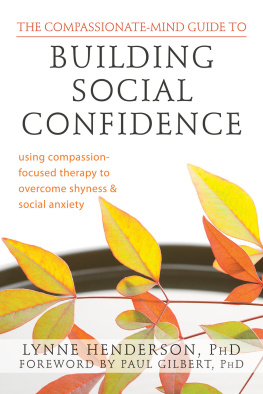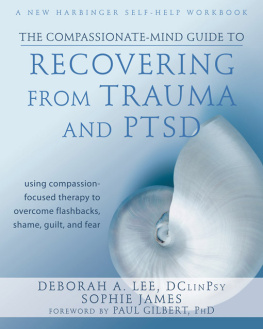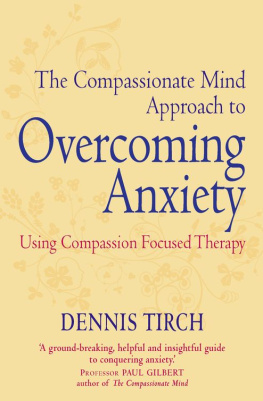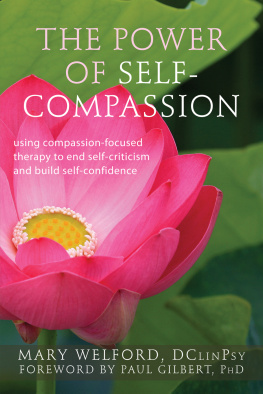Lynne Henderson, PhD, is a clinical psychologist, founder of the Social Fitness Center, and founder and codirector, with Phillip Zimbardo, of the Shyness Institute in Berkeley, CA. She has been a visiting scholar in the psychology department at Stanford University, and is a faculty member in Stanfords Continuing Studies program. She has directed the Shyness Clinic for over twenty-five years and is an adjunct research faculty member at the Institute for Transpersonal Psychology. Her research interests include translating the results of social psychology and personality theory into treatment methods for shyness, the influence of personality variables and cultural influences on interpersonal perception, cultural influences on self-conceptualizations, interpersonal motivation, leadership styles, distance collaboration, and mindful social fitness.
Foreword writer Paul Gilbert, PhD, is a professor at the University of Derby in the United Kingdom, director of the mental health research unit at Derbyshire Mental Health Trust, and author of The Compassionate Mind.

Publishers Note
This publication is designed to provide accurate and authoritative information in regard to the subject matter covered. It is sold with the understanding that the publisher is not engaged in rendering psychological, financial, legal, or other professional services. If expert assistance or counseling is needed, the services of a competent professional should be sought.
Distributed in Canada by Raincoast Books
Copyright Lynne Henderson 2010. First published in the UK by Constable, an imprint of Constable & Robinson, Ltd, 2010.
Copyright 2011 by Lynne Henderson
New Harbinger Publications, Inc.
5674 Shattuck Avenue
Oakland, CA 94609
www.newharbinger.com
All Rights Reserved
EPub ISBN: 978-1-60882-867-8
Acquired by Tesilya Hanauer; Cover design by Amy Shoup; Edited by Nelda Street
Library of Congress Cataloging-in-Publication Data on file with the publisher
Henderson, Lynne.
The compassionate-mind guide to building social confidence : using compassion-focused therapy to overcome shyness and social anxiety / Lynne Henderson ; foreword by Paul Gilbert.
p. cm.
Includes bibliographical references.
ISBN 978-1-57224-976-9 (pbk,)
1. Social phobia. 2. Social phobia--Treatment. I. Title.
RC552.S62H46 2011
616.85225--dc22
2011002537

Preface
Lets start with a brief account of my history with shyness. What is now the Palo Alto Shyness Clinic developed from the Stanford Shyness Clinic, which was set up in 1977 and opened to the public shortly before I became director in 1982. The Stanford Shyness Clinic, in turn, had grown out of a famous study by Philip Zimbardo in 1971, in which normal college students were randomly assigned the role of prisoner or guard in a simulated prison in the basement of the psychology building. The study was supposed to run for two weeks, but the prisoners became so anxious and the guards so cruel that it had to be stopped after six days. Phil and his students formed a seminar to try to understand what had happened. During their discussions, one of his students said that shyness was like being both a prisoner and a guard toward the self. The prisoner self wanted to come out but was afraid, and the guard self was hostile and kept the prisoner trapped. Inspired by this insight, Phil and his students established the shyness clinic and started to gather data that culminated in Zimbardos book, Shyness.
From the time I became director of the Shyness Clinic, Phil Zimbardo served as a consultant, research supervisor, and collaborator. Through my work with groups of shy people over the following years, I began to realize that the vast majority of extremely shy and socially anxious people did not lack social skills when they felt accepted and respected. In fact, they demonstrated considerable social skills when they were not in the spotlight. I also noticed that they were conscientious and collaborative, and considerate of other group members. They were enormously relieved to be with other people they liked and respected who also considered themselves shy. Each usually held the self-perception of being the most shy and inadequate in the group. I became struck more by their strengths than their weaknessesbut I also saw how much they struggled with shame and self-blame, and how great their suffering could be. And yet in spite of that, we usually managed to have a good time in the groups, with humor and laughter at ourselves playing a big role.
These shy people were so hard on themselves and felt so much shame that I realized they felt stigmatized for their shyness and considered it a disease that needed a cure. That seemed to me absolutely the wrong way to look at the problem, because it led them to feel powerless to change their own situation. So I decided that treatment needed to be based on an approach where people were treated with respect as colleagues, learning alongside me and my fellow practitioners what it might take for all of us to be socially fit. So, at the clinic, we gently refused their invitations to be dominated and instead requested their input on role-plays, asked them to offer criticism and comments on the book we used for social skills training, and invited them to give us feedback on whether or how much particular exercises in the groups helped and how they felt toward us. When they began to confront me, the groups became very lively, and soon the participants were beginning to take leadership roles in the group. From there we moved on to work on developing trust, verbal and nonverbal self-expression, listening skills, nonverbal communication, handling conflict, and self-assertion.
In this new phase of the work, we addressed negative automatic thoughts, such as When people see my discomfort, they feel superior; People do not identify with me when I am uncomfortable; People will be rejecting and hurtful if I let them close to me. Listening to what clients said in groups and comparing this to what students (both shy and non-shy) said on the same points, we discovered that our clients in the shyness clinic had more of these negative automatic thoughts about others than either shy or nonshy students. These findings suggested that chronically shy people and those with social anxiety disorder (discussed in chapter 1) also had difficulty trusting others, in that they viewed others as critical, condescending, and hurtful. We also found that although, through group work in the clinic, our clients were able to reduce self-blame and shame, negative thoughts about others, resentment, shyness, and depression, once the group work was over, they still seemed to have trouble managing their emotions. I wanted to find ways to help clients hold on to what they had gained in treatment, and to find out what would help them cultivate compassion for themselves in the long term and manage their emotions. With these aims in mind, I explored mindfulness techniques with the intention of incorporating them in treatment at the clinic.
That is when I met Paul Gilbert. I had heard about his work in compassionate mind training, was fascinated and impressed, and wanted to learn more. I attended a workshop in England and realized I needed to learn a lot more about the compassion-focused therapy he was developing, which seemed to me to have enormous potential for treating chronic shyness and social anxiety disorder.













